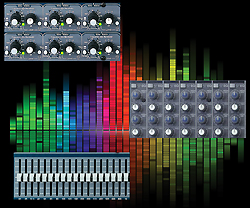
ROOM INDEPENDENT
And now for the hard part, but the most important part: If doing measurements outside (no reflections off walls or ceiling) and up in the air (no reflections off the ground), the primary goal is getting a very accurate picture of just the loudspeaker’s response, free from room effects.
This provides the room-independent response, which is really important because no matter where this box is used, it has these problems.
Of course, be sure the cost of the budget loudspeaker plus the equalizer is substantially less than buying a really flat loudspeaker system. This comes about quite often.
But remember, the truth is that most cabinets are not flat. It is only the very expensive loudspeakers (incorporating advanced DSP correction) that have world-class responses. (Maybe that’s why they cost so much!)
Another thing to be achieved with equalizers is to improve the way each venue sounds. Every room sounds different – fact of life, fact of physics. Using exactly the same equipment, playing exactly the same music in exactly the same way, different rooms sound different, guaranteed. Each enclosed space treats your sound differently.
Reflected sound causes the problems. What the audience hears is made up of the direct sound (what comes straight out of the loudspeaker directly to the listener) and reflected sound (it bounces off everything before getting to the listener).
And if the room is big enough, then reverberation comes into play, which is all the reflected sound that has traveled so far, and for such a (relatively) long time that it arrives and re-arrives at the listener delayed enough to sound like a second and third source, or even an echo if the room is really big.
It’s basically a geometry problem. Each room differs in its dimensions; not only in its basic length-by-width size, but in its ceiling height, the distance from you and your equipment to the audience, what’s hung (or not hung), on the walls, how many windows and doors there are, and where.
Every detail about a space affects sound. And regretfully, there is very little that can be done about any of it. Most of the factors affecting sound cannot change. The room dimensions can’t be changes; the windows and door locations can’t be altered. But there are a few things that can be done, and equalization is one of them.
Before equalizing, it’s vital optimize how and where the loudspeakers are placed. This is probably the number one item to attend to. Keep loudspeakers out of corners whenever possible. Remove all restrictions between the loudspeakers and audience, including banners, stage equipment, and performers.
The idea is for most of the sound the audience hears to come directly from the loudspeakers, with all reflected sound minimized. With careful loudspeaker selection and placement, combined with proper equalization, then the direct sound output should be good. So what’s left is to minimize the reflected sound.
BEEF UP OR ROLL OFF
Use equalization to help with some of a room’s more troublesome features. If the room is exceptionally bright, beef up the low end to help offset it, or roll off some of the high end.
Or, if the room tends to be boomy, tone down the low end to reduce the resonance by either reducing the bass response or by notching out those frequencies to prevent excitation of those particular room resonances.
